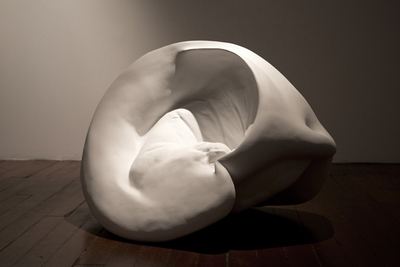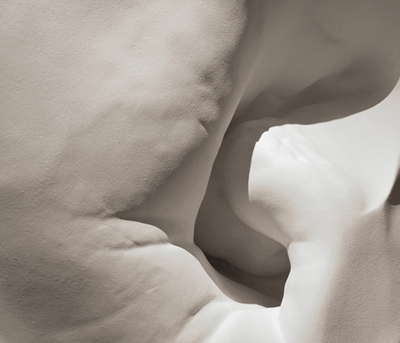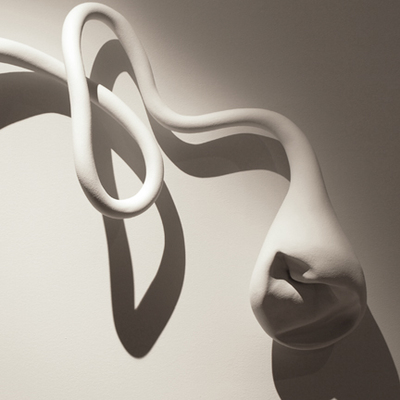Duality and Contradiction in the Art of Alwar Balasubramaniam
By Bansie Vasvani
Can authenticity be a yardstick for judging a work of art regardless of its ethnic or
geographical origin? This question looms large as one walks into Alwar Balasubramaniam’s solo exhibition at the Talwar Gallery in downtown Manhattan. We are confronted by a series of works that push us to understand and probe what is unseen.

Alwar Balasubramaniam, Unfold, 2012
Appropriately titled Nothing from my Hands, Bala’s current exhibition continues to explore the theme of absence found in his previous works. In Link, a fishing hook attached to a length of string appears magically suspended in mid-air, tautly stretched across two adjacent walls. In order to create this illusion, the artist manipulates the wall surface from where the string emerges to make it seem as soft and pliable as fabric. At the other end, a magnet embedded in the wall attracts the hook such that the string remains horizontal without any visible support. In Bala’s art the constant interplay between the visible and the invisible challenges our comprehension of what is real and unreal. Through the deliberate absence of any perceivable exegesis to the magic of Link, his practice focuses on calling attention to the fallacy of our perception of things as they are.
Bala’s series titled Kayaam, translated as “invisible body” from its origin in the south Indian language Tamil, is a set of four wall sculptures in pure white fiberglass and acrylic. Devised from rubber casts of his own body that are completely contorted before being recast in fiberglass, these strange yet highly representational sculptures of the human form are explorations of bigger questions. Bala’s eerily flaccid though tactile structures that float on the wall seem to be stripped to their bare essentials and compel us to question what defines and what confines us. By working at the threshold of the physical and visible, these scrunched up, recognizable but disfigured bodies challenge a conception of what we expect to see. The viewer’s response and engagement with the work is tantamount to Bala’s creative process and repeatedly demonstrates the preoccupation of his oeuvre to investigate new territories.

Alwar Balasubramaniam, Unfold, 2012
The sculpture in the second room of the gallery compounds Bala’s quest towards formulating a new reality. In Unfold, also cast from the artist’s body in white fiberglass and acrylic, the materiality of the object is turned inside out. Using the outer form of what appears to be his ear, Bala’s dark cavernous structure explores a part of the body where the inner and outer are so closely linked that it is difficult to decipher where one begins and the other ends.
By casting works using his own body the artist literally places himself between the art and the viewer. Seen through this free flowing, organic yet amorphous form, the artist’s self and the other exist as one. An austerity pervades his snow white, pristine sculpture that accentuates its beauty. By continually dismantling our visible association of the human body, he creates a new level of understanding between the subject and the object. The notion of the absence of accessible meaning that is endemic to his work implies its converse in his ceaseless effort to give form to the formless.

Alwar Balasubramaniam, Unfold (detail), 2012
Playing with the idea of duality and contradiction is deeply rooted in Bala’s artistic endeavor. In his Untitled works of acrylic, silkscreen and traces of fire, the artist demonstrates his view of the importance of a trace as a remnant of any phenomena. He uses the burnt marks from the sun that he captures on paper to record its presence. Yet for Bala the point of the work is to establish the presence of something through its absence and vice versa. In other words, if it were not for the burnt marks we would not be aware of the power of the sun. He believes that “Art lies in the realm between science, which demands proof and is based on material reality, and spirituality which is based on experience and not evidence.”
Bala’s work challenges the prevailing ideological commitment to categorization. Free of any specific cultural signifiers that would identify him as an Indian artist, his work remains true to his beliefs and is deeply faithful in its exploration of his concerns. Bala’s art adheres to the two important qualities required of authentic material; namely, communicative potential and relevance. His exhibitions often raise questions of the artist’s ethical responsibility to his cultural roots.

Alwar Balasubrmaniam, Hold Nothing (detail), 2012
As a viewer, I question whether the value of art is diminished by its lack of recognizable cultural icons. I believe our conception of art has been sufficiently democratized such that artists located in the east can be influenced by the Euro-American tradition without being deemed derivative and secondary. Bala’s work, much like Anish Kapoor’s, stays clear of the Indian and non-Indian nomenclature which is narrow and restrictive. Similar to Kapoor’s sculpture that recalls the indigenous spiritual tradition, his work is best understood as a synthesis between western modernist abstraction and Indian spirituality. In his quest for a universal aesthetic to represent the nature of human existence, Bala’s art stays clear of any exoticisms. To be penalized for its non-Indian elements would completely trivialize the artist’s endeavor. Ultimately, his art is best judged by its authenticity and appreciated for its malleability that appeals on a number of levels simultaneously.
Nothing from my Hands runs through August 31, 2012 at Talwar Gallery, 108 East 16th St., New York, New York.
Bansie Vasvani is an independent art critic and writer. She lives in New York City.
